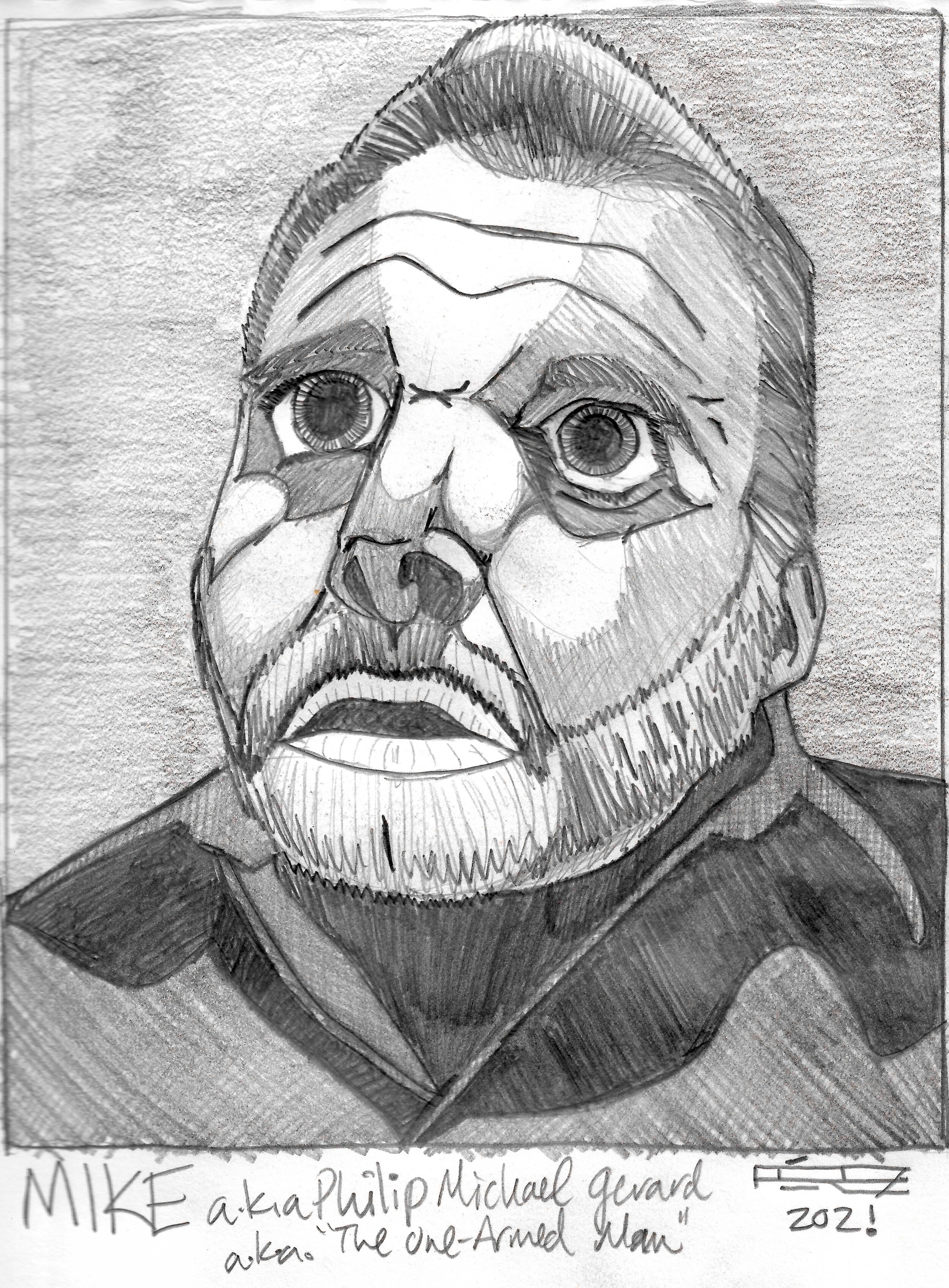Mystery Man
artwork by Jonathan Pérez
NOTE—This article contains **SPOILERS** through Twin Peaks Season 2 Episode 9 “Arbitrary Law”
He’s there in the pilot, if only for a moment. A one-armed man exits an elevator at Calhoun Memorial Hospital. Deputy Tommy “Hawk” Hill (Michael Horse) makes note of the white-haired and bearded one-armed man. There is an air of ominousness. But this is Twin Peaks—would a creepy old man with one arm be any less weird or ephemeral as a high schooler doing the boogie down a hallway or coming face to face with a llama? Thankfully, David Lynch and Mark Frost decided to have Philip Michael Gerard, a.k.a. The One-Armed Man, a.k.a. MIKE (Al Strobel) stick around.
Like many characters on Twin Peaks, MIKE (and I am going to use the capitalized name of the inhabiting spirit here for ease of typing unless distinction needs to be made) was never intended to be crucial to the overall narrative. MIKE could very well remain one of those one-time eccentric ciphers within the show. In one of the many instances of network meddling, ABC would finance the filming of the pilot episode unless a version with an ending that would resolve the murder of Laura Palmer was also cut. ABC’s line of thinking was to hedge their bet; if the pilot didn’t get picked up for full series it could be direct to video in Europe as a feature. The canonical bit where MIKE gets off the elevators, spied by Hawk, does set up the non-canonical ending to the International Pilot. There is a climactic confrontation between MIKE and BOB, and Strobel is substantially featured. That scene has MIKE recite the famous “Fire Walk With Me” poem. Strobel, as quoted in Reflections: An Oral History of Twin Peaks by Brad Dukes, says “There was this crazy monologue that clearly established that I was not playing an ordinary person. Mark Frost said the hair stood up on the back of his neck when he saw the rushes. That was not only the key to my character, but as it turned out, a major clue to understanding the whole project.”
MIKE is such a tricky role; he is almost as much of a plot device as he is a character, Strobel has to deliver a ton of expository dialogue, and there’s a level of expectation surrounding the character that I feel is unfair for an actor to have to live up to. After all, in the seminal CBS series The Fugitive viewers tuned in each week to see if Dr. Richard Kimble would finally find the One-Armed Man who murdered his wife and thus clear his name. Reinforcing The Fugitive connection is the name of MIKE’s human host, Phillip Gerard, which is the name of Kimble’s pursuer. The finale of The Fugitive garnered 28 million viewers (with a 72 share) so television history would have primed audiences’ curiosity around one-armed men. Luckily, Strobel lives up to the hype and lets the audience experience the same hair-raising performance that so compelled Frost and Lynch.
The part also plays into Lynch’s obsession with the grotesque. His early feature films Eraserhead and The Elephant Man feature grotesque characters both surreal and from real life. Furthermore, Lynch extends sympathy and humanity to these characters. The piercing and incessant cries from the alien baby in Eraserhead evoked in me a paternal feeling of protection and nurturing. John Hurt’s performance as John Merrick in The Elephant Man is the epitome of dignity. Yet Lynch’s grotesquerie can also contain characters deeply unsettling and violent. The reveal of the unwrapped baby in Eraserhead is the most unsettling moment in a film of unsettling moments. And Dennis Hopper’s Frank Booth—the villain of Blue Velvet—is humanity in its most grotesquely twisted form. With MIKE, Lynch gets to have a character that touches on all these aspects. Strobel is truly chilling when reading the “Fire Walk With Me” poem, and yet, when we see Philip Gerard shirtless in the Season One Episode “The One-Armed Man” he is confused and vulnerable.
Lynch, it should be known, also fought the network to show Strobel with his shirt off, with ABC taking the stance that a shirtless one-armed man would offend the sensibilities of family audiences. Lynch asserted his final cut privileges here and insisted that Strobel’s shirt stay off. Not only does Lynch do the right thing by sticking up for the humanity of his actor—Strobel really did lose his left arm in an automobile accident as a teenager—but knows it will add to the grotesque mystique of the character. Lynch knows that some audiences are perhaps scared or frightened of the unknown and some are perhaps intrigued or awestruck. No matter what you feel toward this character, you can’t take your eyes off him.
MIKE gets a fantastic scene where all the elements with his character combine to deliver an indelible moment. In Season 2, Episode 6, “Demons”, the pursuit of MIKE by the Twin Peaks Sheriff’s Department comes to a climax. As he is being interrogated by Special Agent Dale Cooper (Kyle MacLachlan), they witness Gerard transform into MIKE. It is a masterful physical performance by Strobel, contorting his torso so his head falls completely backward, as he emerges up, his eyes roll forward and the transformation is complete. In an ominously clue laden speech MIKE explains some of the origins of his character, his relationship to BOB, and new leads for law enforcement to pursue.
Al Strobel’s performance here is what all the actors in the show, in ways large and small, strive to do: show us one side of the character, playing off our prejudices and assumptions, then metamorphize into something completely unexpected. It is this sense of mystery and the excitement of the unknown that keeps Twin Peaks such a rewarding experience to return to.


